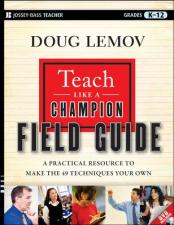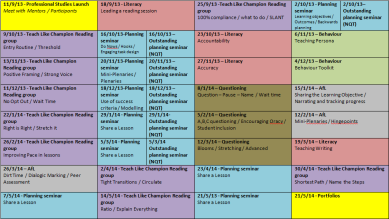Setting Up a Professional Development Programme From Scratch
When I started my job as Professional Mentor within my school, I was lucky enough to be able to set up my CPD programme completely from nothing. This meant that I was able to act upon what I had long thought about CPD from my time as a trainee: that something needed to be done to increase the take-up from abstract learning within training sessions to using techniques and strategies in day-to-day classroom practice. In this post, I want to share the different elements of my programme and the principles I followed to try and ensure that they were as effective as possible. Each element of this programme relates to some CPD resources that have posted here.
Fundamentally, the whole programme was designed to avoid the CPD Paradox. To do this, I decided that each session within the programme should be planned with the following important principles in mind: sessions should be – as far as possible – participant led, be designed so that participants were held accountable to make changes to their practice and should contain in-built uptake time, giving time to practice or employ techniques within the confines of the session.
Below is the calender that I created for the training in 2013-14. There is a session each week (one hour, run after school), lasting from the second week in September until the final week of the first half of summer term. Broadly speaking, I began with participants learning things that they would need early on, for example basic literacy skills for class reading, behaviour management and the core elements of lesson planning. As the weeks went by, I then moved towards more advanced skills such as questioning and assessment for learning. Equally, the planning skills we dealt with throughout the year moved from basics such as writing objectives to more complex issues like differentiation. I also decided to run a reading group that lasted the entire year on Doug Lemov’s ‘Teach Like a Champion’, a book I consider to be the best resource for trainee teachers out there. More of this below.
Below, I will briefly outline each element of the programme, discussing how the sessions themselves were run and designed to avoid the CPD Paradox. The sessions themselves and a more detailed breakdown of each session can be found to download in the ‘ CPD Resources‘ section of the site.
1) Teaching for Literacy (hour long sessions)
All the trainee teachers in my school were expected to run morning reading groups, so it was important that they all had a grasp of techniques to ensure effective whole-class reading sessions. Even without this, however, being a good ‘reading teacher’ is a vital element for any teacher, no matter what subject. Since being a teacher of literacy is about utilising a series of techniques for dealing with the accountability (i.e., are students actually reading?), accuracy and comprehension issues that arise, I wanted the session to consist mostly of teachers actually practising the techniques on each other. This would mean that when they went ‘live’ in front of class, they would already have a bank of techniques at their finger tips. Such sessions avoid the CPD paradox because they are, at least in part, participant led and have in-built uptake time at their core. The rough outline for the sessions is below:
- ‘Expert’ session leader teaches the techniques (20-30mins)
- Trainees get into micro-teaching groups and are supplied with the following resources:
- Reading materials (books / articles that students might read in class)
- A list of common mistakes / problems with whole class reading (not following along / issues with decoding / problems in comprehension etc.,) that students normally make when reading in class
- One trainee acts as teacher while the others act as students reading in class, making sure to make the same reading errors that students would in a real session. The teacher uses the techniques from the session to address these issues, as they would in a real class, trailing and practising the techniques ‘live’.
- Trainees swap until everyone has had a turn as teacher
2) Teach Like a Champion reading group
To my mind, Teach Like a Champion by Doug Lemov is the best book aimed to help teachers develop key teaching skills in a variety of areas. In particular, the ‘Field Guide’ is perfect for in-school CPD because each of the 59 techniques is accompanied by training activities and video clips. In short, it is the perfect book for a participant-led CPD programme.

I set up this aspect of my programme so that it was completely controlled by the participants themselves. I had my NQTs take turns to lead the sessions, while the first year trainees were the ‘participants’, although in truth both first and second years participated equally. After each session, I then paired up NQTs with first years to complete drop-in lesson observations and ensure that the techniques were being used. The only work I actually had to do was to group the techniques into ones that worked logically together within individual sessions.
Basic session outline:
- ‘The Lesson’ (20-30mins) – The NQT session leader teaches the skills like a lesson, modelling the particular skills concerned all the way through,
- Session leader uses the CPD materials, readings and video provided in the CPD handbook,
- They are also free to create their own resources, although this is not expected.
- ‘Uptake time’ (20-30 mins) – Participants (NQTs and first years mixed up) go into small groups, and plan mini-lessons using the techniques. They deliver these to each other, either in small micro-teaching groups, or to the whole group.
- Plenary – NQTs and TFs pair up into observation pairs and look at each others’ timetables to arrange peer observations.
Through these sessions I aimed to give participants a foundation in good lesson planning, from writing learning objectives at the start of the year to using success criteria and models later on. Sessions like these are in danger of becoming, I think, the most useless because unless participants are given the time to use their new knowledge then and there, the pressures of teaching mean that the gap between ‘knowing’ and ‘using’ becomes so large that the session is essentially rendered pointless. To combat this, I decided to include 30 minutes of planning time so that participants are given the opportunity to use the learning immediately; they spend the second half of the session – with some guidance from the session leader – planning the techniques into lessons for the next few days or weeks.
4) Outstanding Planning Seminar
This session, which runs at exactly the same time as the Planning Seminar, is just for NQTs (2nd year trainees who have already passed their basic teaching qualification) and is designed to push their lesson planning towards ‘Outstanding’. I wanted this to be much more about the NQTs themselves directing their own learning, so they took it in turns to run the sessions. In the first, I gave them a ‘success criteria’ for an Outstanding lesson, comprising all the elements that might contribute towards a great lesson, as well as a list of ‘Critical Friend’ questions to use to coach each other. Each session, the NQTs took it in turns to demonstrate a lesson, as if the others in the session were students. We would then critique the lesson against the criteria. All of these resources can be found to download here.
In my experience as a trainee teacher, CPD sessions on behaviour management can be the most useless, as there is a vast gulf between hearing in the abstract about techniques and actually applying these live in a real classroom situation, with students. They are, as a result, most vulnerable to the CPD Paradox: trainees can go to dozens of sessions about good classroom management while their real life practice stays exactly the same. I attempted to solve this problem through building time to actually practice classroom management skills within the sessions:
Basic session outline:
- ‘Expert’ session leader ‘teaches’ the techniques (20-30mins)
- Trainees get in to micro-teaching groups, and plan mini-lessons using the techniques
- Trainees act as teacher / students, and practice using the techniques on each other
- If time, trainees plan out specific examples of when they will use the techniques in a lesson for the next day.
6) Questioning and Assessment for Learning
Questioning, just like behaviour management, is another area in which teaching can be seen to be a performative, skill based profession. Embedding effective questioning skills in teaching practice is simply a matter of using the techniques again and again until they become a routine behaviour. Thus, my questioning sessions, which ran from basic techniques such as giving Wait Time to asking probing and deep questions, were structured in exactly the same way as my behaviour management sessions, with at least half the session dedicated to practice.
This post is only intended as a brief outline to my programme and the individual components that make it up – for further detail, please look in the CPD Resources section, where I have posted many of my sessions.
If you have any questions, feel free to post them as comments on this blog or to email me at josh.goodrich@gmail.com.
